MODR1770 - Persuasion Techniques: An Analysis of Reasoning Modes
VerifiedAdded on 2023/04/08
|6
|1298
|99
Essay
AI Summary
This essay delves into the modes of reasoning and techniques of persuasion, focusing on the contentious issue of abortion and human rights. It examines the arguments surrounding the rights of the unborn child versus the rights of the mother, referencing a passage that discusses the increasing prevalence of legal abortions and the potential erosion of individual sanctity. The author critiques the passage for its perceived bias, advocating for a more balanced consideration of both the mother's and the child's rights, particularly in cases of rape or life-threatening pregnancies. The essay identifies causal fallacy within the argument, highlighting the need for a comprehensive evaluation of the pros and cons of abortion. It concludes by emphasizing that both the mother and the unborn child possess the right to life and that legal decisions should reflect a nuanced understanding of complex circumstances. Desklib provides access to similar essays and study resources for students.
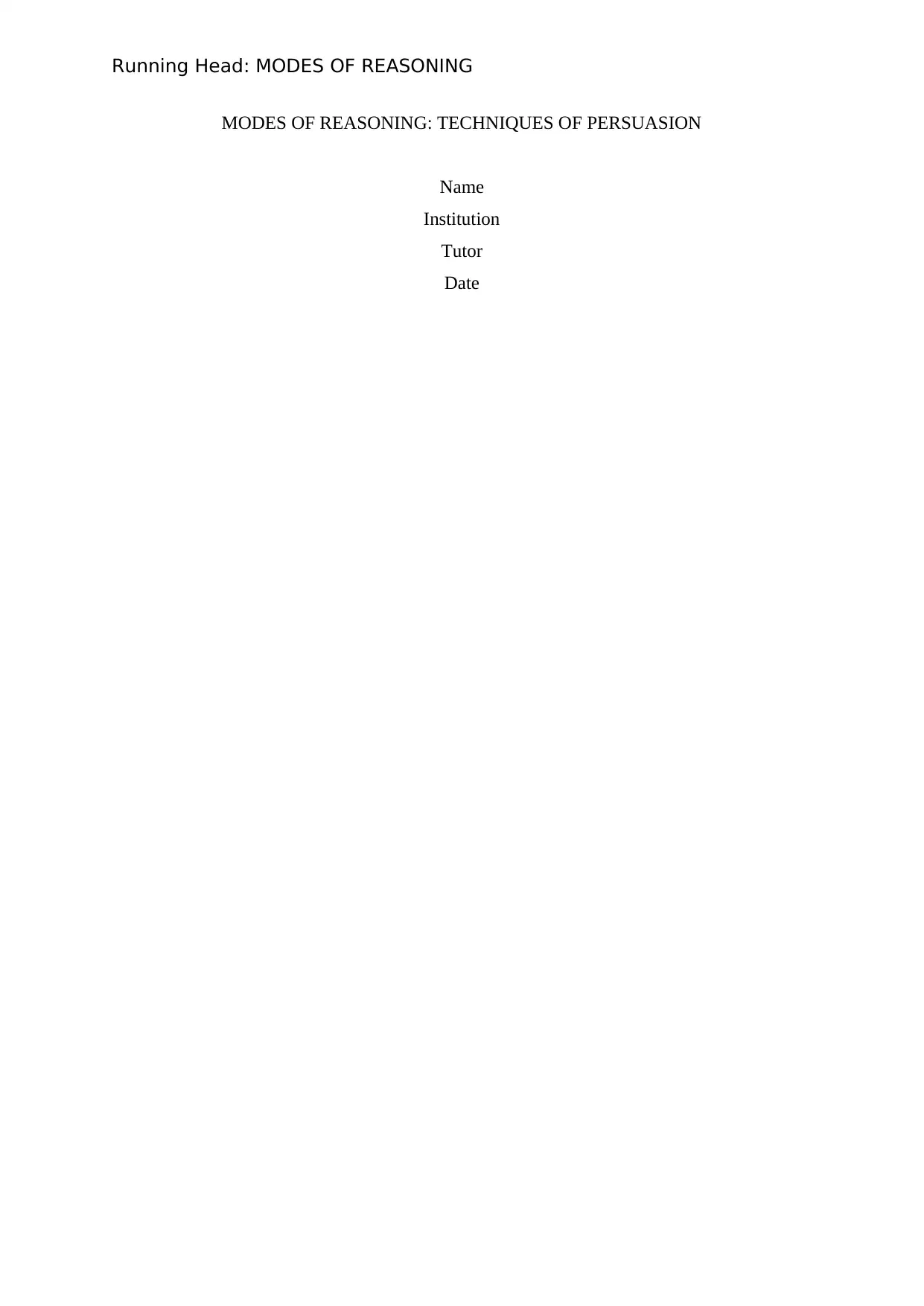
Running Head: MODES OF REASONING
MODES OF REASONING: TECHNIQUES OF PERSUASION
Name
Institution
Tutor
Date
MODES OF REASONING: TECHNIQUES OF PERSUASION
Name
Institution
Tutor
Date
Paraphrase This Document
Need a fresh take? Get an instant paraphrase of this document with our AI Paraphraser
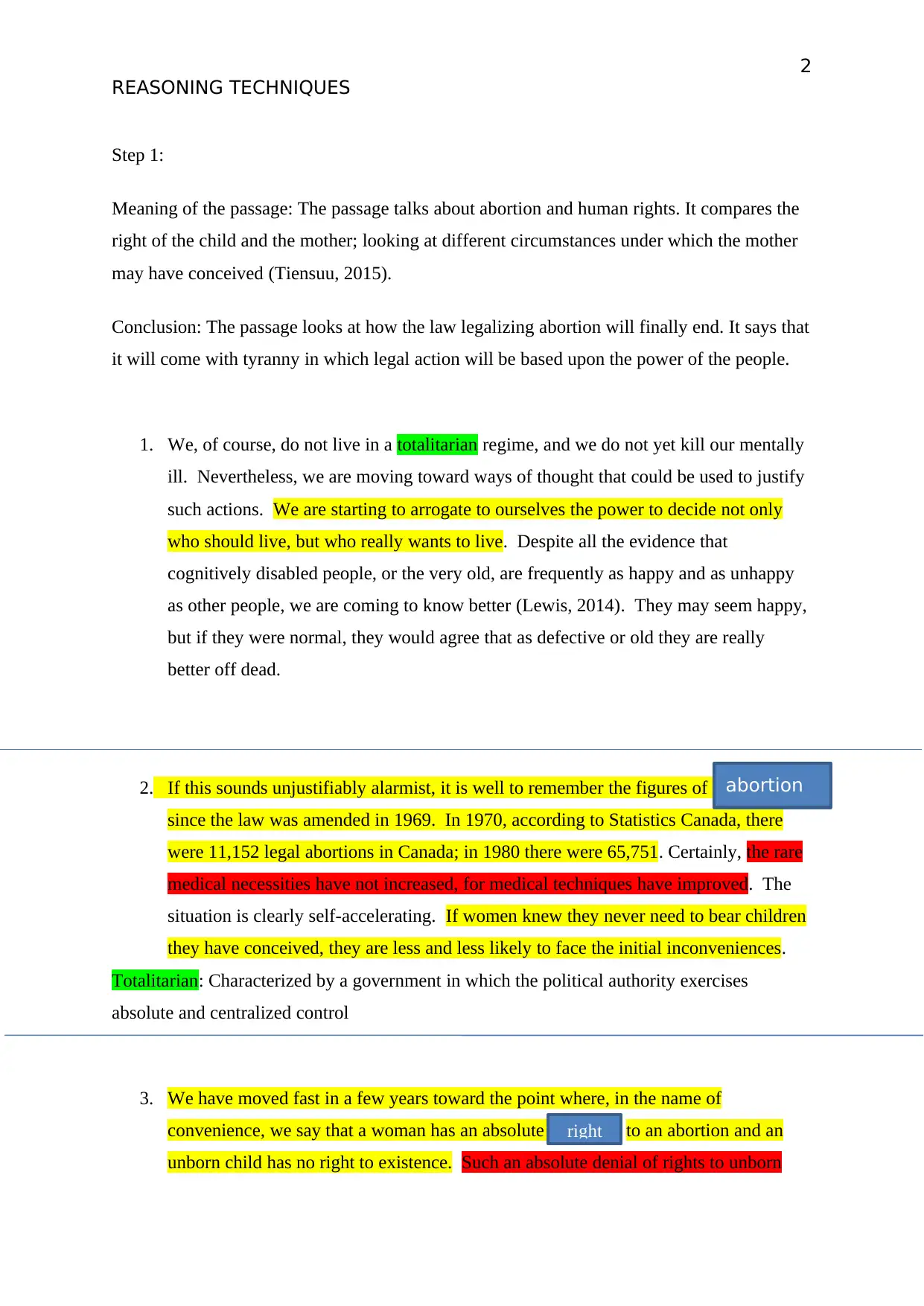
2
REASONING TECHNIQUES
Step 1:
Meaning of the passage: The passage talks about abortion and human rights. It compares the
right of the child and the mother; looking at different circumstances under which the mother
may have conceived (Tiensuu, 2015).
Conclusion: The passage looks at how the law legalizing abortion will finally end. It says that
it will come with tyranny in which legal action will be based upon the power of the people.
1. We, of course, do not live in a totalitarian regime, and we do not yet kill our mentally
ill. Nevertheless, we are moving toward ways of thought that could be used to justify
such actions. We are starting to arrogate to ourselves the power to decide not only
who should live, but who really wants to live. Despite all the evidence that
cognitively disabled people, or the very old, are frequently as happy and as unhappy
as other people, we are coming to know better (Lewis, 2014). They may seem happy,
but if they were normal, they would agree that as defective or old they are really
better off dead.
2. If this sounds unjustifiably alarmist, it is well to remember the figures of abortions
since the law was amended in 1969. In 1970, according to Statistics Canada, there
were 11,152 legal abortions in Canada; in 1980 there were 65,751. Certainly, the rare
medical necessities have not increased, for medical techniques have improved. The
situation is clearly self-accelerating. If women knew they never need to bear children
they have conceived, they are less and less likely to face the initial inconveniences.
Totalitarian: Characterized by a government in which the political authority exercises
absolute and centralized control
3. We have moved fast in a few years toward the point where, in the name of
convenience, we say that a woman has an absolute right to an abortion and an
unborn child has no right to existence. Such an absolute denial of rights to unborn
abortion
right
REASONING TECHNIQUES
Step 1:
Meaning of the passage: The passage talks about abortion and human rights. It compares the
right of the child and the mother; looking at different circumstances under which the mother
may have conceived (Tiensuu, 2015).
Conclusion: The passage looks at how the law legalizing abortion will finally end. It says that
it will come with tyranny in which legal action will be based upon the power of the people.
1. We, of course, do not live in a totalitarian regime, and we do not yet kill our mentally
ill. Nevertheless, we are moving toward ways of thought that could be used to justify
such actions. We are starting to arrogate to ourselves the power to decide not only
who should live, but who really wants to live. Despite all the evidence that
cognitively disabled people, or the very old, are frequently as happy and as unhappy
as other people, we are coming to know better (Lewis, 2014). They may seem happy,
but if they were normal, they would agree that as defective or old they are really
better off dead.
2. If this sounds unjustifiably alarmist, it is well to remember the figures of abortions
since the law was amended in 1969. In 1970, according to Statistics Canada, there
were 11,152 legal abortions in Canada; in 1980 there were 65,751. Certainly, the rare
medical necessities have not increased, for medical techniques have improved. The
situation is clearly self-accelerating. If women knew they never need to bear children
they have conceived, they are less and less likely to face the initial inconveniences.
Totalitarian: Characterized by a government in which the political authority exercises
absolute and centralized control
3. We have moved fast in a few years toward the point where, in the name of
convenience, we say that a woman has an absolute right to an abortion and an
unborn child has no right to existence. Such an absolute denial of rights to unborn
abortion
right
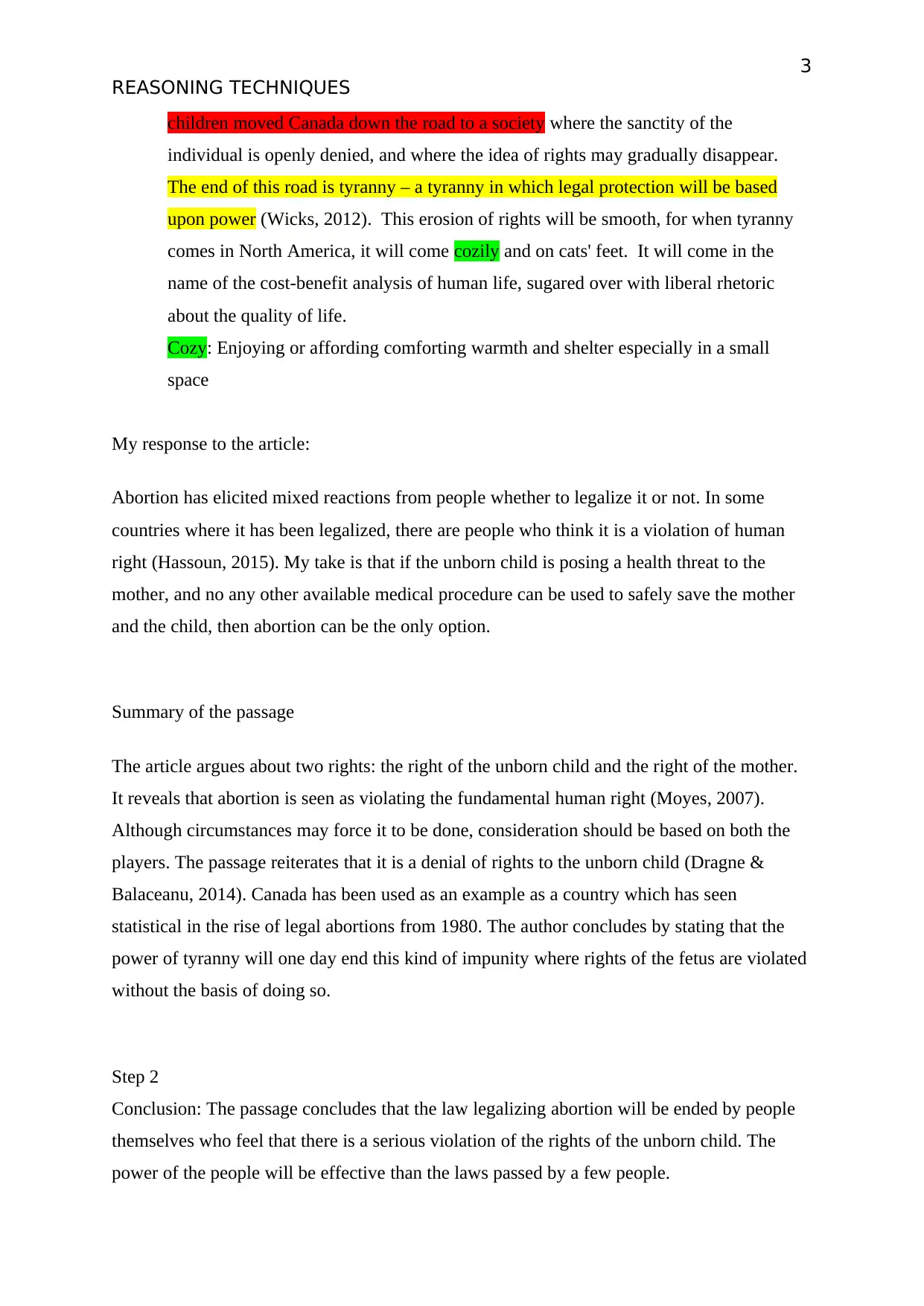
3
REASONING TECHNIQUES
children moved Canada down the road to a society where the sanctity of the
individual is openly denied, and where the idea of rights may gradually disappear.
The end of this road is tyranny – a tyranny in which legal protection will be based
upon power (Wicks, 2012). This erosion of rights will be smooth, for when tyranny
comes in North America, it will come cozily and on cats' feet. It will come in the
name of the cost-benefit analysis of human life, sugared over with liberal rhetoric
about the quality of life.
Cozy: Enjoying or affording comforting warmth and shelter especially in a small
space
My response to the article:
Abortion has elicited mixed reactions from people whether to legalize it or not. In some
countries where it has been legalized, there are people who think it is a violation of human
right (Hassoun, 2015). My take is that if the unborn child is posing a health threat to the
mother, and no any other available medical procedure can be used to safely save the mother
and the child, then abortion can be the only option.
Summary of the passage
The article argues about two rights: the right of the unborn child and the right of the mother.
It reveals that abortion is seen as violating the fundamental human right (Moyes, 2007).
Although circumstances may force it to be done, consideration should be based on both the
players. The passage reiterates that it is a denial of rights to the unborn child (Dragne &
Balaceanu, 2014). Canada has been used as an example as a country which has seen
statistical in the rise of legal abortions from 1980. The author concludes by stating that the
power of tyranny will one day end this kind of impunity where rights of the fetus are violated
without the basis of doing so.
Step 2
Conclusion: The passage concludes that the law legalizing abortion will be ended by people
themselves who feel that there is a serious violation of the rights of the unborn child. The
power of the people will be effective than the laws passed by a few people.
REASONING TECHNIQUES
children moved Canada down the road to a society where the sanctity of the
individual is openly denied, and where the idea of rights may gradually disappear.
The end of this road is tyranny – a tyranny in which legal protection will be based
upon power (Wicks, 2012). This erosion of rights will be smooth, for when tyranny
comes in North America, it will come cozily and on cats' feet. It will come in the
name of the cost-benefit analysis of human life, sugared over with liberal rhetoric
about the quality of life.
Cozy: Enjoying or affording comforting warmth and shelter especially in a small
space
My response to the article:
Abortion has elicited mixed reactions from people whether to legalize it or not. In some
countries where it has been legalized, there are people who think it is a violation of human
right (Hassoun, 2015). My take is that if the unborn child is posing a health threat to the
mother, and no any other available medical procedure can be used to safely save the mother
and the child, then abortion can be the only option.
Summary of the passage
The article argues about two rights: the right of the unborn child and the right of the mother.
It reveals that abortion is seen as violating the fundamental human right (Moyes, 2007).
Although circumstances may force it to be done, consideration should be based on both the
players. The passage reiterates that it is a denial of rights to the unborn child (Dragne &
Balaceanu, 2014). Canada has been used as an example as a country which has seen
statistical in the rise of legal abortions from 1980. The author concludes by stating that the
power of tyranny will one day end this kind of impunity where rights of the fetus are violated
without the basis of doing so.
Step 2
Conclusion: The passage concludes that the law legalizing abortion will be ended by people
themselves who feel that there is a serious violation of the rights of the unborn child. The
power of the people will be effective than the laws passed by a few people.
⊘ This is a preview!⊘
Do you want full access?
Subscribe today to unlock all pages.

Trusted by 1+ million students worldwide
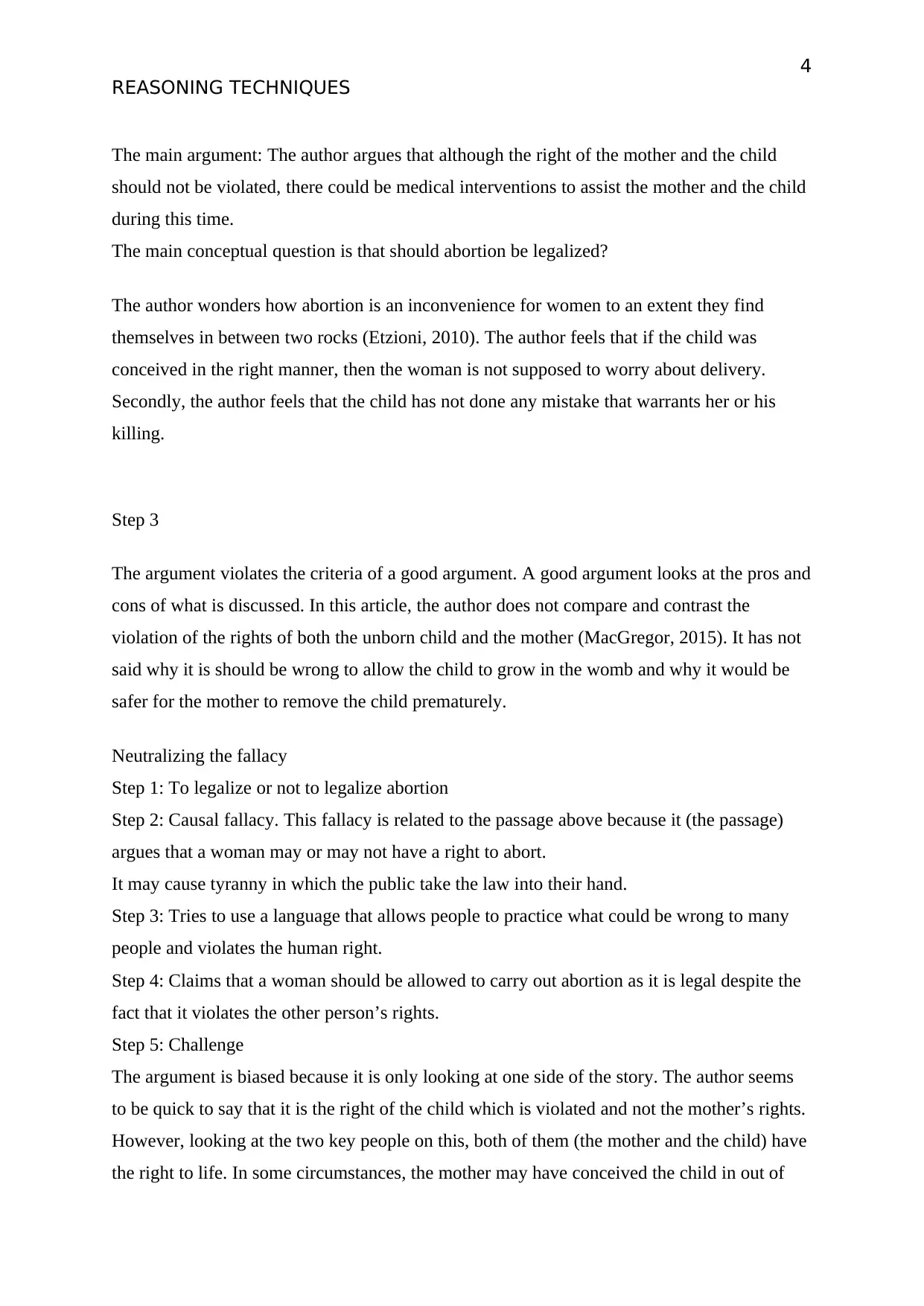
4
REASONING TECHNIQUES
The main argument: The author argues that although the right of the mother and the child
should not be violated, there could be medical interventions to assist the mother and the child
during this time.
The main conceptual question is that should abortion be legalized?
The author wonders how abortion is an inconvenience for women to an extent they find
themselves in between two rocks (Etzioni, 2010). The author feels that if the child was
conceived in the right manner, then the woman is not supposed to worry about delivery.
Secondly, the author feels that the child has not done any mistake that warrants her or his
killing.
Step 3
The argument violates the criteria of a good argument. A good argument looks at the pros and
cons of what is discussed. In this article, the author does not compare and contrast the
violation of the rights of both the unborn child and the mother (MacGregor, 2015). It has not
said why it is should be wrong to allow the child to grow in the womb and why it would be
safer for the mother to remove the child prematurely.
Neutralizing the fallacy
Step 1: To legalize or not to legalize abortion
Step 2: Causal fallacy. This fallacy is related to the passage above because it (the passage)
argues that a woman may or may not have a right to abort.
It may cause tyranny in which the public take the law into their hand.
Step 3: Tries to use a language that allows people to practice what could be wrong to many
people and violates the human right.
Step 4: Claims that a woman should be allowed to carry out abortion as it is legal despite the
fact that it violates the other person’s rights.
Step 5: Challenge
The argument is biased because it is only looking at one side of the story. The author seems
to be quick to say that it is the right of the child which is violated and not the mother’s rights.
However, looking at the two key people on this, both of them (the mother and the child) have
the right to life. In some circumstances, the mother may have conceived the child in out of
REASONING TECHNIQUES
The main argument: The author argues that although the right of the mother and the child
should not be violated, there could be medical interventions to assist the mother and the child
during this time.
The main conceptual question is that should abortion be legalized?
The author wonders how abortion is an inconvenience for women to an extent they find
themselves in between two rocks (Etzioni, 2010). The author feels that if the child was
conceived in the right manner, then the woman is not supposed to worry about delivery.
Secondly, the author feels that the child has not done any mistake that warrants her or his
killing.
Step 3
The argument violates the criteria of a good argument. A good argument looks at the pros and
cons of what is discussed. In this article, the author does not compare and contrast the
violation of the rights of both the unborn child and the mother (MacGregor, 2015). It has not
said why it is should be wrong to allow the child to grow in the womb and why it would be
safer for the mother to remove the child prematurely.
Neutralizing the fallacy
Step 1: To legalize or not to legalize abortion
Step 2: Causal fallacy. This fallacy is related to the passage above because it (the passage)
argues that a woman may or may not have a right to abort.
It may cause tyranny in which the public take the law into their hand.
Step 3: Tries to use a language that allows people to practice what could be wrong to many
people and violates the human right.
Step 4: Claims that a woman should be allowed to carry out abortion as it is legal despite the
fact that it violates the other person’s rights.
Step 5: Challenge
The argument is biased because it is only looking at one side of the story. The author seems
to be quick to say that it is the right of the child which is violated and not the mother’s rights.
However, looking at the two key people on this, both of them (the mother and the child) have
the right to life. In some circumstances, the mother may have conceived the child in out of
Paraphrase This Document
Need a fresh take? Get an instant paraphrase of this document with our AI Paraphraser
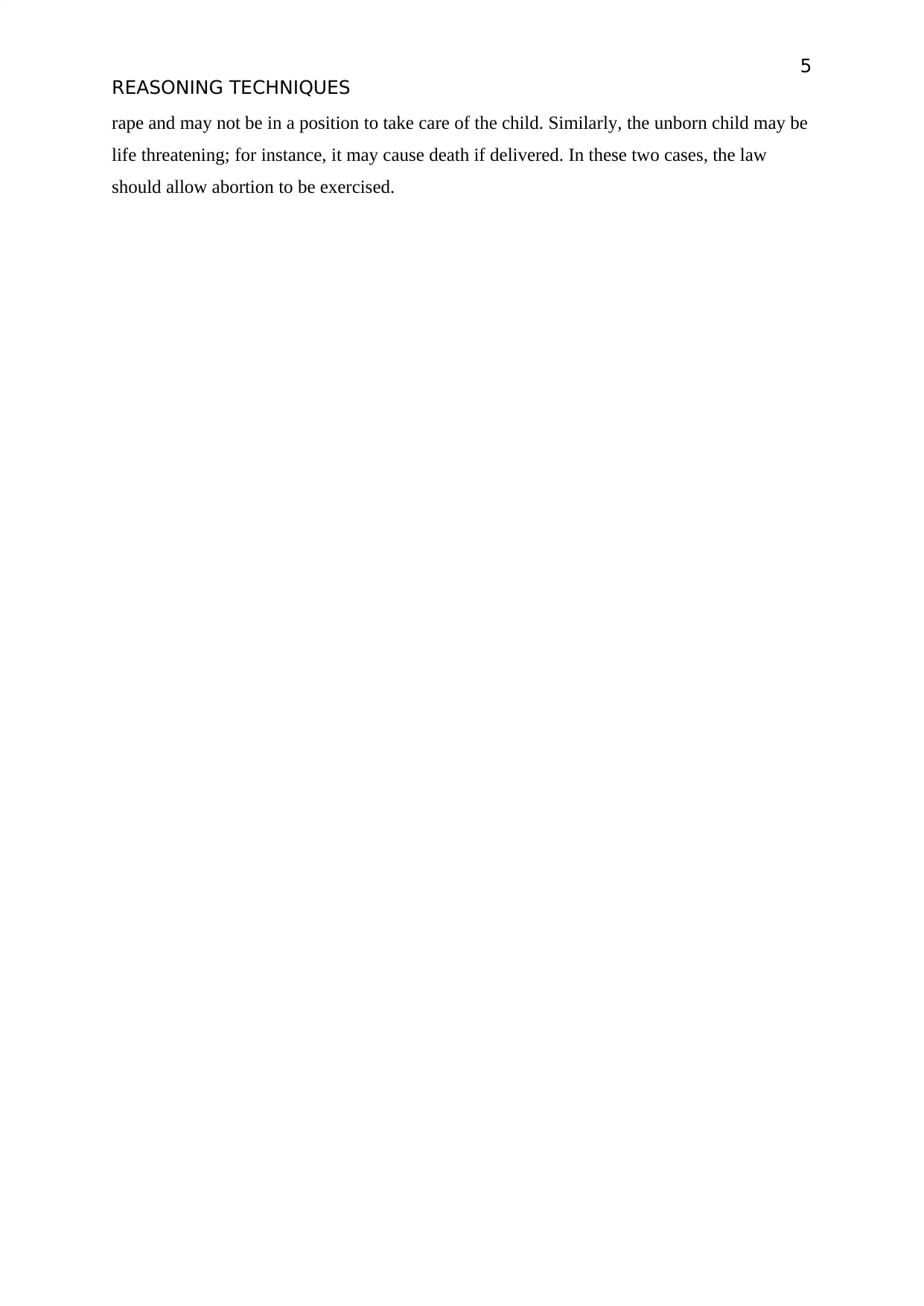
5
REASONING TECHNIQUES
rape and may not be in a position to take care of the child. Similarly, the unborn child may be
life threatening; for instance, it may cause death if delivered. In these two cases, the law
should allow abortion to be exercised.
REASONING TECHNIQUES
rape and may not be in a position to take care of the child. Similarly, the unborn child may be
life threatening; for instance, it may cause death if delivered. In these two cases, the law
should allow abortion to be exercised.
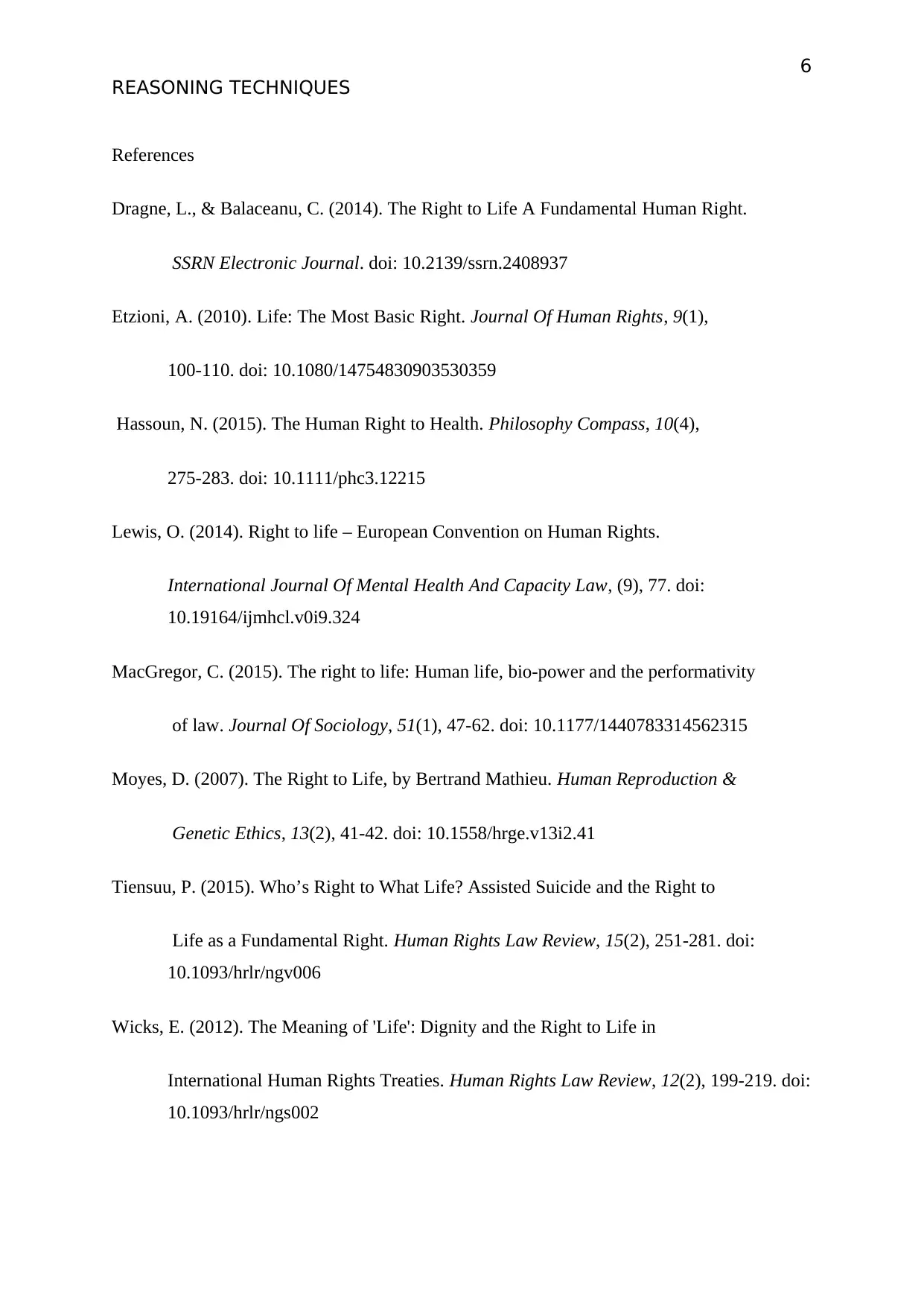
6
REASONING TECHNIQUES
References
Dragne, L., & Balaceanu, C. (2014). The Right to Life A Fundamental Human Right.
SSRN Electronic Journal. doi: 10.2139/ssrn.2408937
Etzioni, A. (2010). Life: The Most Basic Right. Journal Of Human Rights, 9(1),
100-110. doi: 10.1080/14754830903530359
Hassoun, N. (2015). The Human Right to Health. Philosophy Compass, 10(4),
275-283. doi: 10.1111/phc3.12215
Lewis, O. (2014). Right to life – European Convention on Human Rights.
International Journal Of Mental Health And Capacity Law, (9), 77. doi:
10.19164/ijmhcl.v0i9.324
MacGregor, C. (2015). The right to life: Human life, bio-power and the performativity
of law. Journal Of Sociology, 51(1), 47-62. doi: 10.1177/1440783314562315
Moyes, D. (2007). The Right to Life, by Bertrand Mathieu. Human Reproduction &
Genetic Ethics, 13(2), 41-42. doi: 10.1558/hrge.v13i2.41
Tiensuu, P. (2015). Who’s Right to What Life? Assisted Suicide and the Right to
Life as a Fundamental Right. Human Rights Law Review, 15(2), 251-281. doi:
10.1093/hrlr/ngv006
Wicks, E. (2012). The Meaning of 'Life': Dignity and the Right to Life in
International Human Rights Treaties. Human Rights Law Review, 12(2), 199-219. doi:
10.1093/hrlr/ngs002
REASONING TECHNIQUES
References
Dragne, L., & Balaceanu, C. (2014). The Right to Life A Fundamental Human Right.
SSRN Electronic Journal. doi: 10.2139/ssrn.2408937
Etzioni, A. (2010). Life: The Most Basic Right. Journal Of Human Rights, 9(1),
100-110. doi: 10.1080/14754830903530359
Hassoun, N. (2015). The Human Right to Health. Philosophy Compass, 10(4),
275-283. doi: 10.1111/phc3.12215
Lewis, O. (2014). Right to life – European Convention on Human Rights.
International Journal Of Mental Health And Capacity Law, (9), 77. doi:
10.19164/ijmhcl.v0i9.324
MacGregor, C. (2015). The right to life: Human life, bio-power and the performativity
of law. Journal Of Sociology, 51(1), 47-62. doi: 10.1177/1440783314562315
Moyes, D. (2007). The Right to Life, by Bertrand Mathieu. Human Reproduction &
Genetic Ethics, 13(2), 41-42. doi: 10.1558/hrge.v13i2.41
Tiensuu, P. (2015). Who’s Right to What Life? Assisted Suicide and the Right to
Life as a Fundamental Right. Human Rights Law Review, 15(2), 251-281. doi:
10.1093/hrlr/ngv006
Wicks, E. (2012). The Meaning of 'Life': Dignity and the Right to Life in
International Human Rights Treaties. Human Rights Law Review, 12(2), 199-219. doi:
10.1093/hrlr/ngs002
⊘ This is a preview!⊘
Do you want full access?
Subscribe today to unlock all pages.

Trusted by 1+ million students worldwide
1 out of 6
Your All-in-One AI-Powered Toolkit for Academic Success.
+13062052269
info@desklib.com
Available 24*7 on WhatsApp / Email
![[object Object]](/_next/static/media/star-bottom.7253800d.svg)
Unlock your academic potential
Copyright © 2020–2025 A2Z Services. All Rights Reserved. Developed and managed by ZUCOL.